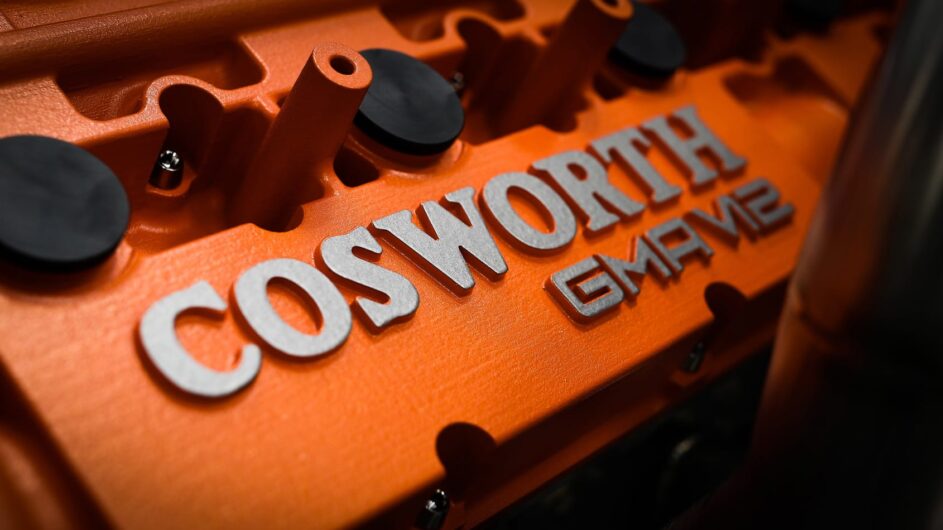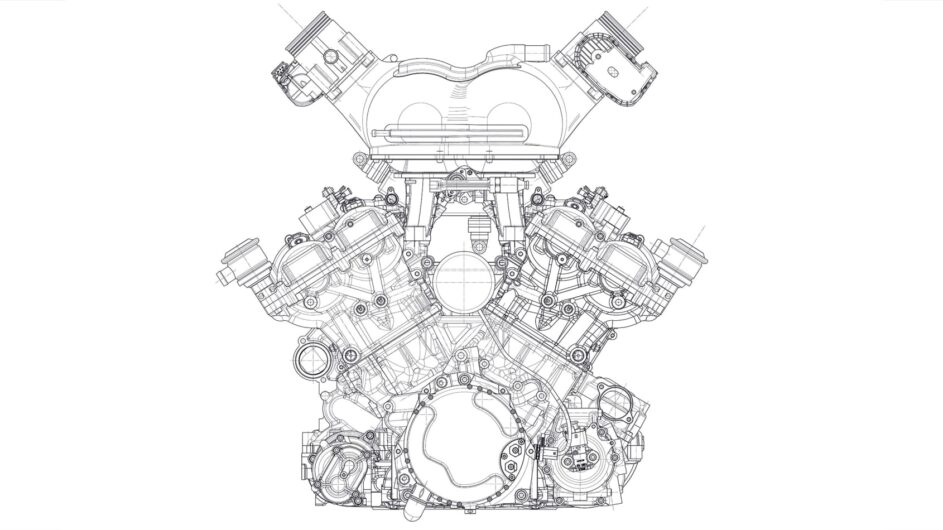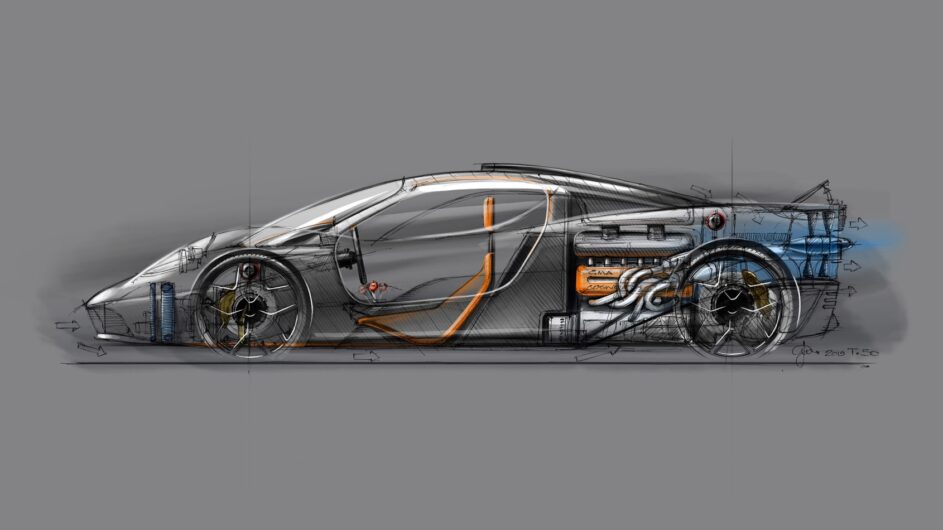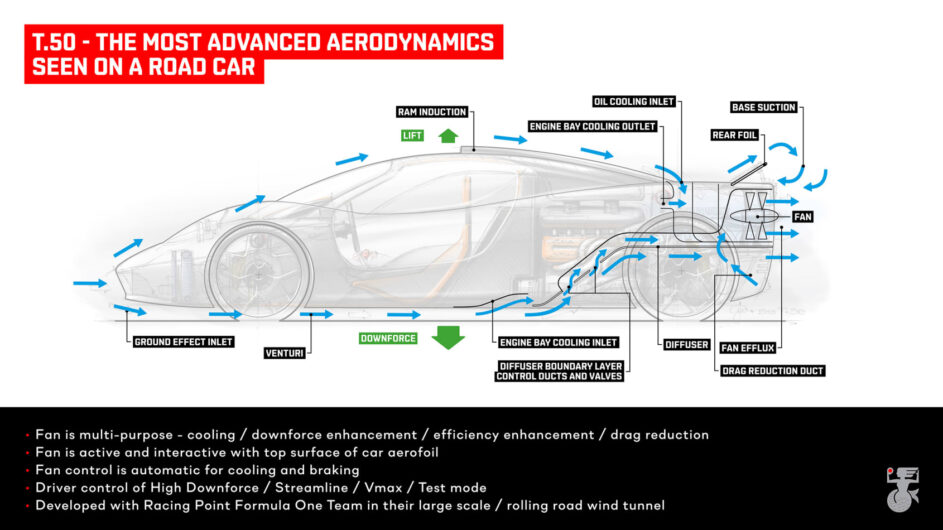Supercar’s bespoke 4-litre V12 to rev to 12,100rpm

Leading up to the Gordon Murray Automotive T.50’s reveal, Gordon Murray and the team have given us further insight into the incredible powertrain that will be powering this ultimate expression of the driver’s supercar.
The engine itself is a small-capacity, high-revving, naturally aspirated V12 built by Cosworth to Murray’s specific design, powering the rear wheels via a close-ratio six-speed manual transmission. To stop there before really getting into the detail would be a disservice to the depth of engineering both the GMA and Cosworth teams have put into this completely bespoke engine though.
It’s worth noting the T.50’s V12 is not the only highly strung V12 engine being built and developed by Cosworth for a low-run British hypercar, with the firm also supplying the V12 found in Aston Martin’s Valkyrie. As a result there are plenty of interesting parallels to consider, but for now here’s a look into Murray’s mind when creating a clean-sheet V12 for his ultimate supercar.
Powertrain details
The T.50’s V12 engine is completely bespoke, and has been specified by Murray to a very specific set of goals in construction, capability and design. The 3994cc V12 is built with a 65-degree cylinder-bank angle, with an 81.5mm bore and 63.8mm stroke. It runs at a 14:1 compression ratio, and at its core has been designed for ultimate response as much as for its power figure.

Peak engine speed is limited to 12,100rpm, but more astonishing is its rev rate per second, gaining a stunning 28.500rpm-per-second, making the engine capable of hitting the red line from idle in just 0.3sec. This is nearly three times faster than the S70/2 V12 in the McLaren F1. To achieve this, the internal moving parts have been shorn of as much weight as possible – the steel crank is just 13kg, the connecting rods and valves are of titanium, all to reduce rotational mass, helping the engine achieve not only those dizzying engine speeds, but the rate of response Murray wanted to achieve.
This also has a lead-on effect of reducing the V12’s overall weight which is 178kg – a record-low weight figure for a naturally aspirated V12 road car engine, and makes it 28kg less than the V12 Cosworth has built for the Aston Martin Valkyrie. The crank is also a record 80mm from the engine base, lowering all the engine’s internals for the sake of weight distribution. Internal engine lubrication is of a dry sump system, naturally.
The power and torque figures are almost secondary to these numbers, with a peak power of 654bhp at 11,500rpm, and a 345lb ft torque peak at 9000rpm. This gives the V12 a power density of 166bhp/litre, which is also an improvement on the Valkyrie’s 154bhp/litre figure.
Almost obsessive measures have been taken in all factors too – there are no belts on the V12, only chains, while a 48V mild-hybrid system and integrated starter motor and generator streamlines the electrical side of things. Murray’s also designed all the V12’s ancillaries to be situated out of sight, making only the headers, exhaust manifolds and intake plenum and trumpets visible from its glazed engine cover. The starter motor and generator also supplement the engine with an extra 49bhp when in VMax powertrain mode.
The intake is fed via a roof-mounted ram-air scoop that borrows Direct Path Induction Sound tech first seen on the McLaren F1. The system essentially amplifies the intake sound from the roof scoop into the cabin, but runs on the basis of throttle position rather than engine speed, keeping the relative noise down when the driver lifts, but also giving a more varied sound under big throttle applications at low (relative to modern engine) revs.
The six-speed manual gearbox is another bespoke commission, this time designed and built by XTrac, weighing 80.5kg, which is another road car record. The shift feel has been painstakingly perfected by Murray himself with a short-throw movement on the compact gearlever sprouting from the left of the central driver’s seat.

| GMA T.50 | Aston Martin Valkyrie | |
|---|---|---|
| Engine size: | 3994cc | 6499.01225944cc |
| Construction: | 65-degree V12 | 65-degree V12 |
| Max power: | 654bhp @ 11,500rpm | 1000bhp @ 7000rpm |
| Max torque: | 654bhp @ 11,500rpm | 546lb ft @ 7000rpm |
| Peak RPM: | 12,100 | 11,100 |
| BHP/litre: | 164bhp/litre | 154bhp/litre |
| Engine weight: | 178kg | 206kg |
Lightweighting
GMA had previously announced the quite staggering 980kg weight figure it’s targeting, but has now gone into further detail about how precisely that extreme figure is to be achieved, and the level of obsessive attention to detail required to reach that goal.
At its core, the T.50’s carbonfibre monocoque chassis and body panels collectively weigh less than 150kg, an astonishingly low figure considering the safety regulations that must be adhered to in 2020. The cabin itself, as previously mentioned, is laid out in a three-seater configuration, with each of the three seats also constructed from carbon. The driver’s seat itself weighs in at a scant 7kg, with each of the passenger seats even less at 3kg.
Other interior components, such as the pedal box, have also been targeted to save weight, coming in at 300 grams less than those of the F1, while the super-thin windscreen is 28 per cent lighter than typical automotive glass applications.
The team had weekly ‘weight watchers’ meetings to review every single component of the T.50 to ensure that there was no surplus weight where it’s not required. Even the T.50’s 900 fixings are all optimised to be only as big and heavy as absolutely necessary when cycled through a digital strength simulation. So far do the savings go we’d not be surprised if the GMA office canteen has a strict ‘no complex carbohydrates’ policy…

Active aero
The GMA T.50’s unique aerodynamic package comprises a combination of elements derived from Gordon Murray’s Formula 1 cars as well as the latest developments made in both modern-day F1 and road car development. Dominating the package is that rear-mounted 400mm fan, which rapidly accelerates the air passing under the car and out of the rear diffuser.
This is combined with a selection of movable aero devices that sit on the T.50’s underfloor, inside the rear diffuser and at the leading edge of the rear end. The underfloor ducting, together with the fan’s unique design, does away with the need for the air ‘skirt’ found on Murray’s F1 cars, while also doubling as further cooling for the mid-engined V12 when required.
In order to take full advantage of the variability of the aero package, the T.50 has a total of six different aero modes, two of which are automatically deployed without driver intervention, and the other four being selectable. Auto Mode is the default, making the system variable in response to driver inputs, while a Braking Mode then activates under heavy braking, lifting the aerofoils and operating the fan at high speed, doubling downforce, therefore enhancing the tyres’ purchase on the road surface for the most effective braking performance.

The four further modes include High Downforce Mode for fast road or track driving by activating the fan and aerofoils. This improves traction and high-speed cornering grip, raising downforce over the default mode by 30 per cent. Streamline Mode reduces drag over the default mode by ten per cent for high- and low-speed cruising, and closes all the underbody ducts and activates the fan at high speeds to extend the trailing wake of air behind the car, in effect creating a virtual long-tail.
VMAX Mode shares this slipperiest of set-ups with Streamline Mode, but adds a further 30bhp of electrical power from the integrated starter-generator to the V12’s crank for up to three minutes, raising peak power to 690bhp.
To validate these modes, GMA has partnered with the Racing Point Formula One team in Silverstone as it moves from virtual to physical testing inside Racing Point’s wind tunnel. The first quarter of 2020 also saw the opening of the Gordon Murray Automotive customer experience and service centre, which will sit alongside the company’s new headquarters and manufacturing facility, which will commence building cars in January 2022.
Though a full reveal is still to come, GMA also revealed an image of the T.50, with a rear-quarter rendering giving our first look at what we can expect from the finished product. Straight away, parallels can be drawn to the F1 in the roof and door structures, but from there the T.50’s relative simplicity in its bodywork and purity of detailing is obvious. The rear is dominated by the fan, which together with movable aerofoils on either side give the T.50 a unique rear aesthetic. The exhaust outlets are also placed high up toward the foils, leaving the diffuser section free of any airflow-corrupting exhaust gases.
A total of 100 units will be built commencing in 2022, priced from $2.5million before local taxes or charges. Given the McLaren F1’s reputation, it’s not surprising to hear that a majority of the build run has already been allocated, with a strong reception from Japan and the US.
This article originally appeared at evo.co.uk
Copyright © evo UK, Dennis Publishing
